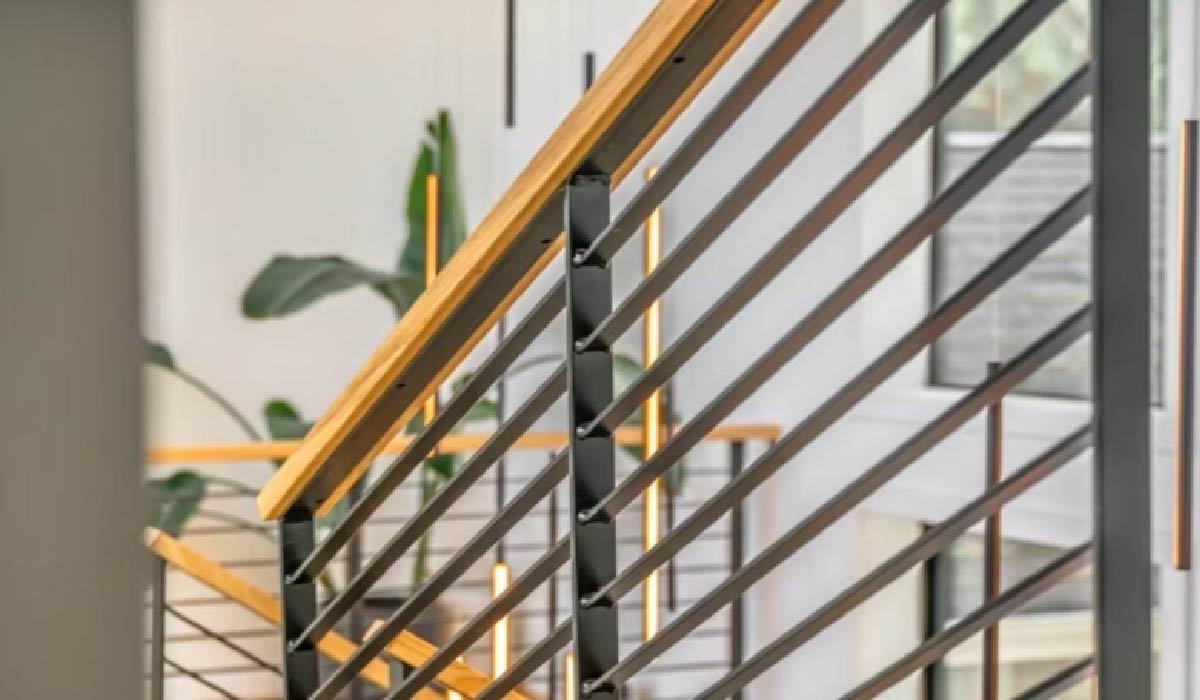Home Improvement
Creative Handrail Ideas: How Small Details Can Transform a Space

In architectural and home décor, the enchantment, many times, lives in the details. Not even big exteriors or impressive stairs, but the small things that matter the most in forming an initial idea. One of those that are most often ignored is the handrails. Still, they give an amazing chance: by clever materials selection, discreet styling, and creative treatments, a mere handrail can change the vibe, evoke feelings, and become a decorative feature while still being a practical item. Delving into innovative handrail concepts unveils the power of the tiniest details to completely change the room.
A Matter of Material: Texture Sets the Tone
Running one’s hand over a polished steel bar is a completely different experience from when a person tries to slide their hand over a gently sanded oak. Texture is one of the quickest and direct ways the handrails convey the mood of a room. Rough or rustic woods, with the visible grain and the edges that have been softened, can bring to mind warmth, nostalgia, and maybe even a country lodge atmosphere. However, metals in their various forms, like stainless steel that has been brushed and polished or brass that has a warm color, can create a sense of a modern, precise, and even clinical atmosphere if they are overly polished. Then, imagine a combination: e.g., the metal parts that a person designed in an architect’s highly-industrial style, which is topped with warm and soft wood of the hand, or the panels that are made by wood and glass, which diffuses the light and creates a contrast of the materials.
Texture, to a certain extent, is also involved in imperfection. The handrail made from live-edge wood keeps the organic curves of the tree; thus, it is compared to the sharply geometrical form of modern architecture, which makes the contrast between two. The wrought iron that has been forged into gentle curves or hand-formed shapes that are handcrafted is the one that indicates craftsmanship, the small irregularities of which have become your trademark. Glass or acrylic are the materials that are translucent, and thus they bring the sleek surface, clean lines, and unobstructed sightlines into a room. In a situation when safety and support are still at a high level, the translucent panels in handrails let the light penetrate, thus visually enlarging the space while still guiding movement and giving the feeling of support by their structure.
Lines and Curves: Form Speaks Volumes
Architecture is the architecture of movement. How people move, how they move, ascend stairs, and reach out to support themselves not only guides the function but also the visual flow of a design. Lines in handrails do not just lead the eyes but also the bodies. Straight, minimal handrails highlight the direction, scale, and perspective; they thus make the eyes move along corridors or stairwells. On the contrary, curved forms only add gentleness and invitation to the space. Spiraling balustrades thus become points of drama; gently undulating rails beside a ramp, on the other hand, offer a sense of calm and flow.
Anchors and terminals (the ends of handrails) are also places where the personality of the product can be revealed. Rather than abruptly ending into posts, an elegant turnback, a scroll, a hidden bracket, all these small details change the handrail from being just a necessity to an artful one. Points where handrails change direction bring in more possibilities for creativity: maybe a decorative elbow, a gradual transition from wood into metal, or even lighting that is integrated into corners to make the geometry visible. The interplay between form and structure can quietly change the experience of moving through a building.
Hidden Techniques: Joinery, Brackets, and Finishes
Rarely seen are those things that have a deep impact. A handrail that is joined by mitered corners, scarf joints, butt joints, or custom welds can be the most unnoticeable elements of a cheap construction that are able to show the structure’s elegance. Invisible fasteners, embedded brackets, and recessed screws are all elements that help to achieve a seamless visual effect. For example, a handrail that is supported by concealed brackets and thus looks as if it is coming out of the wall without any support, gives a sense of lightness; whereas one that is mounted with ironwork might be showing the tradition or period styling.
The choice of finishes adds even more subtlety. A bronze finish with a patina that reminds one of old buildings can be very rich; a polished copper can bring warmth to an otherwise very simple space; matte powder-coated colors can give you a strong color choice that will be in harmony with your branding or the interior themes. Moreover, even metal finishes can be varied with different techniques like oxidation, hammered surface, and sandblast to add texture and dimension. Paints and sealants can be made in such a way that brackets disappear into the walls or stand out boldly, depending on the design goals.
Light and Shadow: Illuminating the Invisible
Creative lighting around handrails can dramatically change the atmosphere of a room, especially when the natural light is fading. LED strips attached to the underside of the rail can provide a gentle glow to the steps thus eliminating the strong shadows that are usually cast, giving a feeling that the feet are being led in the right direction. Moreover, the lighting that is installed within the handrail’s underside or side edges not only provides visibility but also allows the aesthetic the hooks and handrail brackets of the wood furniture to be illuminated, which further makes the detail visible and the wood appears to be textured and naturally grained.
Even reflective surfaces used cleverly can be a light source amplifier. Polished metals that are cleaned well are able to trap and reflect the surrounding light; glass panels that are etched or frosted help in the distribution of the light. Nearby lamps that are installed and aimed at the handrail’s underside are able to provide different shadow and light layers. A designer can play with the different materials of a handrail and the light sources (both natural and artificial) in order to create an experience of dawn, dusk, and candlelight that is new and different from the norm.
Color, Hue, and Accents: The Quiet Power of Tone
Painted handrails do not necessarily mean very bright colors and flashy paint; most of the time, subtle color differences within a family of colors, such as warm beiges, cold greys, and soft whites, can make the greatest impact in bringing the handrail and the surrounding surfaces into harmony. Even so, energetic accent hues might have their say. A handrail lowered into a deep blue or a dark green can be a line of focus, especially in neutral stairwells, which is a place where the eye can be attracted. As a result, small things as painted bracket edges, colored seams, or even inlaid colored strips in the handrail may become one of the ways to show a handrail’s personality.
Metallic hues like gold, copper, and black are carriers of stories. A brushed gold handrail suggests luxury; matte black edges have a feeling of modern or industrial style; antique bronze is a speaker of tradition. The point is in restraint: highlighting accent colors in such a way that they become the underscore rather than a dominating part. A very small colored strip or a barely noticeable inlay can reflect the brand, be in harmony with the other materials, and still match the walls, floors, lighting, and furniture.
Transparency and Open Views: Glass and Cable Innovations
When spaces are cramped or sightlines are important, the use of transparent or semi-transparent materials such as glass panels or tensioned cable infill can completely change the way one perceives the space. What used to be a stairwell that is visually cut off by solid walls is now a space that looks and feels quite airy. Unblocked views may be had of a courtyard, through the floors, or across levels. Metal posts with glass panels inserted between them or even the use of frameless glass with the least number of clamps are some of the ways that the safety aspect of the design can be maintained without a total give-up of the feature of openness.
Cable railings in which stainless steel cables are stretched between two posts or a wall have a lighter visual profile. They are almost unnoticeable from a distance and therefore are perfect for places where there is a beautiful view. Due to their thinness, cable infill can hardly be seen, and thus, the design of the building or the view out of the window is what people would notice the most. On the other hand, the engineering and tensioning should be absolutely correct; otherwise, the cables may become slack or lose tautness, which in turn would affect both safety and aesthetics. The same level of precision that is required in the beautiful part of the design is also needed in the invisible technical performance.
Mixing Materials: Contrasts that Tell a Story
The combination of materials, the contrast of warmth and cold, solid and transparent, natural and artificial, makes the product more valuable. A wooden handrail mounted on black steel supports combines a softer side with the industrial edge. A glass panel that meets a brass cap is an example of classic craftsmanship meeting modern minimalism. Such contrasts do more than look interesting; they make the viewers focus on those areas which are transitions between levels, between spaces, between public and private zones, and thereby guide movement gently.
Materials can also tell stories about a product’s origin and values. The use of sustainably sourced hardwood, metals forged locally, and recycled glass infill can be three ways to show commitment towards the environment. Reclaimed woods bring the past; handmade tiles on adjacent walls or floors can reflect the color or pattern that has been used in the handrail design. When guests feel a rail that has the warmth of timber or the subtle difference of handcrafted finishes, the space becomes more human, more intentional.
Scale, Proportion, and Spatial Connection
Perception of a handrail is influenced by its scale, diameter, height, and the distance from the walls or partitions. If it is too large, then a handrail “drags” a light, airy space with it; on the other hand, if it is too small, it may appear like it is made of fragile material or it is not a part of that place. Proportion is important in connection with architecture: high ceiling foyers, open riser stairs, mezzanines, etc. – each of these features demands a different character of the handrail. In massive entrance halls, a polished handrail of large size and heavy materials can become the “horizontal” of the “vertical”. In small corridors, slender, linear designs are compatible with the movement of the people.
Spatially, handrails that connect these places, such as turning corners, crossing landings, and miters at junctions, have a great impact on how continuous or fragmented a design is felt. A handrail that is continuous and flows around landings gives a feeling of being intentional, while one that interrupts at a half-landing gives a break in rhythm. Smooth turns, identical detail, and unified material are the factors that contribute to the feeling that the design has been thought through almost at every point. This very attention elevates a space from merely functional to an artful one.
The Middle Ground: How Handrails Can Balance Safety & Style
While we sometimes imagine sleek and stylish designs, the reality is that safety comes before everything else. Certain codes in building outline the size, strength, the ability to endure weights, the space that should be left from walls, the size of the grip, and the use of materials that are not slippery. The safety measures should be implemented in such a way that they are not visible so that they do not hamper the achievement of the set aesthetic goals. Things like rounded edges, having a grip that is of the same size, joints that are made in a way that one cannot get caught, are some of the subtle but necessary features. In places that are not very visible, light or reflective things may be of some help. In parts where the hands are most likely to get wet, such as near doors, pools, and bathrooms, it is very important that the materials and finishes chosen are moisture-resistant, slip-resistant, and resistant to corrosion.
Balancing the artistic and the practical is quite within the realms of possibility. For example, a rail that might seem fragile when looked at from its side could be made of sturdy steel on the inside. A wooden cover might just be there to hide the supports of the structure. Also, the grooves that are there to prevent one from slipping can be used for decoration instead of just being there as a warning. You will most likely get the best results with solutions where the seams are not visible, lighting is hidden, and finishes are durable by partnering with fabricators who not only understand safety engineering but also know the design nuances.
Inspiration and Sources: Browsing Possibilities
When searching for the kind of handrail designs that spark imagination, it helps to see what others have done. Galleries of completed projects, manufacturer catalogues, and design showrooms offer glimpses into possibilities of how others have handled lighting, material transitions, joinery, or color. A source that combines both practical product options and design ideas can be particularly helpful; one such place is handrails, where you can explore a variety of profiles, materials, finishes, and mounting styles, yielding combinations you might adapt or reimagine for your space.
Seeing a beautifully curved metal railing with wood infill, or observing how a bracket treatment reframes a staircase, or how a glass panel is etched to both provide privacy and pattern all these can seed ideas. Sometimes the solution is to remix what you like: perhaps the grip of one rail, the finish of another, the lighting approach of a third. Inspiration, when combined with your own spatial constraints and aesthetic goals, leads to the most surprising transformation.
Stories in Application: Transforming Everyday Spaces
Imagine the scenario where you would find a handrail of live-edge teak that has been carved from a slab and the LEDs underneath are softly lighting the stairs at your foot level in a small café that you just entered through the staircase of the entrance. The warm wood and irregular contours of the handrail would be tempting the touch of your fingers; the LEDs would be casting a soft light at foot level. The contrast with polished concrete on the walls appears to be deliberate. Alternatively, you could visualize a boutique hotel that utilizes the slim brass tubes to support glass panels along the mezzanines. During the day, reflections dance across the walls that are sunlit; at night, concealed downlights that are used for highlighting joints and edges, turning shadows into texture.
Really, even the less glamorous parts of the building get a refresh: a hospital corridor with cable infill railing and rounded aluminum cap is more welcoming than a steel bar of plain design. The stairs in the school with handrails that are decorated with color accents and coordinated wall graphics encourage the climb. Office spaces that have minimalist stainless steel rails which have been polished to match door hardware show the standard of the office. The verdict of the stories is that they are depicting the detail of the design that range from a turned end cap, custom bracket, or material switch that changes the mood of your space.
Embracing Detail: The Lasting Impressions
Memory often retains the smallest touches. The cold side of a brushed stainless grip, the joinery where wood meets metal, the way lighting draws out textures, the subtle curve at the end of a bar these are all sensations, very few people recognize, but still they are noticed. They determine the difference between spaces that look like they are the same from the factory and spaces that have been designed in a certain way. Additionally, designed spaces result in emotional connection; they are perceived as more human.
By committing the texture, form, finish, and lighting of handrails to memory one is actually investing in the narrative of his or her space. One communicates to people that safety is important, aesthetics are important, and every point of contact counts. Usually, changing a space is not a huge and radical job; it can be only a change of material, a slight adjustment of the edge, changing the bracket style or the lighting in a different manner. Consequently, handrails in those decisions become the design fabric’s threads instead of the last-minute additions.
-

 Celebrity1 year ago
Celebrity1 year agoWho Is Jennifer Rauchet?: All You Need To Know About Pete Hegseth’s Wife
-

 Celebrity1 year ago
Celebrity1 year agoWho Is Mindy Jennings?: All You Need To Know About Ken Jennings Wife
-

 Celebrity1 year ago
Celebrity1 year agoWho Is Enrica Cenzatti?: The Untold Story of Andrea Bocelli’s Ex-Wife
-

 Celebrity1 year ago
Celebrity1 year agoWho Is Klarissa Munz: The Untold Story of Freddie Highmore’s Wife
















